|

1. Project analysis
1) statistical analysis
Analytic statistics of data and content of project to be translated in advance.
High-frequency words statistics, terminology extraction, calculation of the workload, estimating / gathering statistics of repeated work and estimating the time cost and effectiveness.
2) Pre-translation
Description: Based on the chosen AI knowledge base, TM + + automatically translates the projects to be translated.
Objective: To reduce the translation workload, improve efficiency and quality, the use of previously accumulated translation of knowledge.
2. Project Management
1) Pre-translation processing
Description: Sort / standardize the project content to be translated, prepare translation environment and create a project base.
Objective: To facilitate the efficient and high quality translation, the use of previously accumulated knowledge, and to facilitate project management.
2) Task allocation
Description: Gather statistics of workload and allocation of project work.
Objective: rational allocation of project tasks.
3) Post-translation processing
Description: After the completion of sub-project content translation / proofreading task, the project manager will integrate the sub-project translation / reviser results (i.e. sub-project base content) into the project base; and the documents collation and project management.
Objective: The project collation and document backup.
3. Project progress control
Description: The project administrator can view the translation of each sub-project and revise progress and the proportion of revised sub-project in the total project; at the same time, remind / prompt the translators / revisers behind the progress.
Objective: to help users the freely control the progress of work to deliver tasks on time.
4. Personnel management
Description: The management of the user
Objective: To achieve management of translators employed by the enterprise (including translators and revisers), including the level management, role definitions, permissions settings, to enhance work efficiency
5. Translation module
1) the software interface
Requirements: the interface is simple and concise, easy to understand and learn, easy to operate, convenient human-computer interactive translation;
2) Input mode
Mouse pointing input, keyboard input, hybrid input. Improve input speed; reduce the mental work intensity and intelligent learning in the process of translation.
Aiming at Chinese-English translation, provides intelligent input prompt to improve input speed and reduce input errors.
3) Term marking
Improve translation quality and reduce the workload of revision.
When multiple translators are on a project together, there must only be a unique translation on the technical terms, the described terminology and translation are defined in the “Glossary” and displayed in the translation interface.
4) Form Translation
Form translating, to translate each unit.
5) Online word search / Translate
Via the Internet (Youdao, Google and other online translation website) quickly and easily search words and use the online translation results as a reference.
6. AI knowledge base
Management and use of translation knowledge
Objective: rational allocation of resources, reducing pressure on the server, and improve the communication speed between client and server.
Entry changes, fast words combining, term definitions, word / phrase / phrase search, example sentence search and TM + + automatic translation.
Knowledge Base Management: supporting user to manage knowledge base, and word bank, sentence bank and AI knowledge base of various languages/ professions.
7. Collaboration / sharing
Purpose: To promote work efficiency, achieve Sharing.
Terminology management: one project per glossary, the creating, modification and maintenance of a glossary and to ensure the uniformity of terminology translation.
Translators / revisers members recommend and upload the terminology via the client-side, modify and confirm by the server (Project Manager).
Translators / revisers members recommend and upload the translation results via the client-side and are automatically saved on the server side.
While cooperating, users can share the results of others in real time, such as words, sentences, sentence types.
Translation help: encounter new words or sentences difficult to understand, can communicate with other translators / revisers.
8. Revision process
Translation revision process is the most important in the translation quality control and it can fully reflect and ensure the capabilities of translation quality control of a company and management capabilities. When the translator has translated all the projects, the system flow enters the revision process.
1) Error checking, locating and replacing
Purpose: Check whether common mistakes appeared in the translator’s translation and ensure high-quality manuscripts.
2) Retain revision marks
Description: For the translation project that has been revised, revision marks retaining is necessary. One is to visually see the revision results, and translators can also be easily aware of their errors and for project that needs proofreading management, the chief examiner can quickly check the revision results and report of the proofreader, and is able to make a final revision.
Objective: To mark the proofreader’s revision operation of the translator’s manuscripts, and save records of these operations.
3) Revision report
Description: According to reviser’s revision results of the translation and the project, revision report is automatically generated. Revision report contains the error rate of translations, as well as the evaluation of translators.
9. Typesetting
1) the generating of translation
Description: Generate translation in a variety of formats
Objective: To achieve rapid generating (optional format) translation
2) customizing fonts
Note: In accordance with user needs to modify the translation font
Objective: Support the customizing of fonts in translation
3) Layout revising
Description: Check whether the translation layout consistent with the original manuscript
Objective: Unified layout of the original and the translation
|



